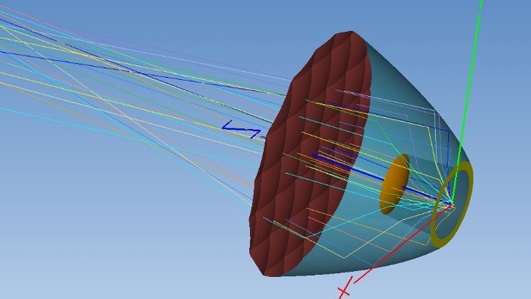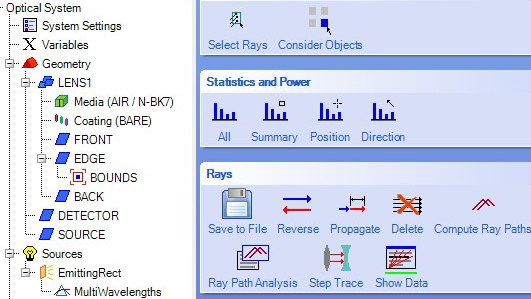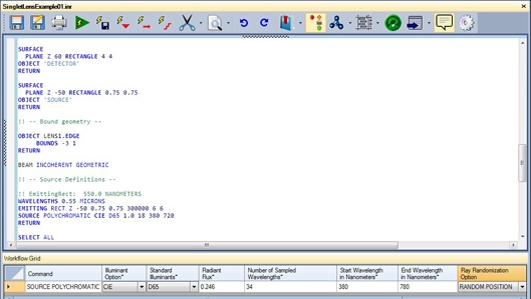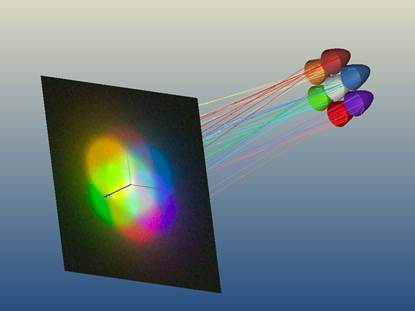Project Description

ASAP
The Most Sophisticated Optical Software Solutions Available
ASAP® is the time-proven industry standard in optical software, offering optical-system designers unmatched capability, flexibility, speed, and accuracy. ASAP accurately predicts the real-world performance of automotive lighting, bio-optic systems, coherent systems, displays, imaging systems, lightpipes, luminaires, and medical devices.

ASAP Defined
ASAP® is the time-proven industry standard in optical software, offering optical-system designers unmatched capability, flexibility, speed, and accuracy. ASAP accurately predicts the real-world performance of automotive lighting, bio-optic systems, coherent systems, displays, imaging systems, lightpipes, luminaires, and medical devices.
Capability
The product of more than 20 years of continuous development, ASAP is able to simulate the physics of more optical systems than any other program available. ASAP unites geometrical and physical optics with full 3D models of optical and mechanical systems. Built-in graphical tools allow visualization of odel geometry, ray-trace details, and results analysis. ASAP handles it all, including scattering, diffraction, reflection, refraction, absorption, polarization, and Gaussian beam propagation.
Flexibility
ASAP is now interoperable with many CAD programs. ASAP can be configured to open native CAA V5 CATIA® files from the program by Dassault Systemes, to write ASAP-specific GTX files from within SolidWorks®, the program by SolidWorks Corp., to write ASAP-specific IGES files from within Rhinoceros®, the program by McNeel & Associates, and to import IGES files from other CAD programs — numerous options for accurate, seamless geometry transitions into ASAP.
ASAP is also able to import (and export) complex vector field distributions from the finite-difference, time-domain code FDTD Solutions™, by Lumerical. Together, ASAP and FDTD Solutions are able to handle both macroscopic optical systems and microstructures in an elegant manner. No other software combination spans such a large optical space.
Speed
The speed-optimized ASAP non-sequential ray-tracing engine is the fastest available, and without the accuracy-compromising surface approximations of other programs. Model almost any conceivable geometry in a single working model, and analyze the behavior of your system in hours instead of weeks.
Accuracy
Optical system designers in 35 countries rely on ASAP for virtual prototyping with great accuracy and confidence. ASAP will model the finest details, which means you can depend on your simulation results to mirror real-world performance.
ASAP Benefits
With ASAP, you get the most sophisticated software program available for creating optical solutions in-house — everything you need to create without compromise and reduce your product development timeline.
Benefits
Comprehensive modeling capabilities for producing groundbreaking, innovative optical designs without costly experimental prototyping iterations
Exclusive interoperability features to address a whole range of problems inaccessible with other software programs
The fastest non-sequential ray-tracing engine available
Results you can count on every time

ASAP
Design and analyze imaging and illumination systems with CAD interoperability
SAP® is powered by the ASAP non-sequential ray-tracing engine — known throughout the optics industry for its accuracy and efficiency. Rays can encounter surfaces in any order and any number of times, with automatic ray splitting. Optimized for speed, ASAP will trace millions of rays in minutes.
Use ASAP to model complex imaging systems, illumination systems, and light-concentrating devices. Create highly accurate source models using source images, point sources, ray grids, and fans. Model incandescent bulbs, LEDs, CCFLs, and HID arc lamps, or import from the BRO Light Source Library. Perform the analyses necessary to validate your designs without experimental prototyping.
Customers in need of CAD software solutions may also purchase a license of SolidWorks® 3D CAD software to complement their ASAP optical software solution. Multiple configurations of SolidWorks Parts, Assemblies, and Drawings are available. SolidWorks is an intuitive 3D-design environment optimized for use with ASAP. Write ASAP geometry files from within SolidWorks, import XML files, or use BRO’s proprietary smartIGES™ system to import system models from SolidWorks and other CAD packages while maintaining fast, efficient ray-tracing speed.
ASAP includes a distributed-processing capability allowing you to complete big design jobs in a fraction of the time required by other tools — spawn up to 5 additional ASAP sessions on your Local Area Network (LAN), without leaving your desk.

ASAP Pro
As the name implies, ASAP PRO is for your toughest optical engineering challenges
ASAP® PRO combines the design power in the standard edition of ASAP with sophisticated features for modeling coherent systems, including Gaussian beam propagation, finite-difference beam-propagation, double-precision ray tracing, and polarization ray tracing. The resulting package is everything you need to turn your creative visions into working prototypes, taking into consideration the most complex of optical phenomena and interoperability challenges.
In addition to fully-featured CAD interoperability and wave optics power, ASAP PRO will import lens-design application files from CODE V®, OSLO®, SYNOPSYS™, and ZEMAX®, and is interoperable with the finite-difference time-domain code FDTD Solutions™. Together, ASAP and FDTD Solutions handle both macroscopic systems and microstructures in an elegant manner — a first in the optics industry. No other software combination spans such a large optical space.
ASAP PRO includes a distributed-processing capability allowing you to complete big design jobs in a fraction of the time required by other tools — spawn up to 5 additional ASAP sessions on your Local Area Network (LAN), without leaving your desk.
| OS | 32-bit OS | 64-bit OS |
| Windows XP Professional | No | No |
| Windows Vista Business | No | No |
| Windows Vista Ultimate | No | No |
| Windows Vista Enterprise | No | No |
| Windows 7 / 10 Professional | No | Yes |
| Windows 7 / 10 Ultimate | No | Yes |
| Windows 7 / 10 Enterprise | No | Yes |
※Note:ASAP is not supported home or Starter editions of any operating systems.
| Hardware | |
| RAM | suggest 64-bit / 16GB |
| Hardware | At least 1T HDD/SSD |
| VGA | All independent graphic card |
| CPU | Intel or AMD with SSE2 support. 64-bit operating system recommended |
| Others | DVD Drive or Broadband Internet Connection |
BIO Toolkit for ASAP
The BIO Toolkit™ for use with ASAP® Optical Software is a set of interactive and example scripts for modeling light propagation and scattering in biological systems. The Toolkit is the only simulation tool available to model light/tissue interactions in human skin at user-defined wavelengths, and to model light propagation in accurate, monocular or binocular human eye models.
Advanced Human Eye Model™ (AHEM™): a flexible eye-model creation system utilizing interactive menus (includes numerous user-defined settings, as well as cloning and positioning tools). Users may customize parameters to build monocular or binocular models, complete with detailed geometry, such as a gradient-index natural lens or a user-designed intraocular lens, and contact or spectacle lenses with realistic optical properties.

Realistic Skin Model™ (RSM™): a flexible skin-phantom creation system utilizing interactive menus to simplify the modeling process (includes hair, blood vessels, and dermal papillae modeling). Users may select a wavelength between 250 and 1000nm and use stored data to model tissue. Alternatively, users may input their own measured data to build custom models.
Biological system models, such as surfaces rendered using CT or MRI scans, often consist of thousands of optically-significant objects. Therefore, the BIO Toolkit is paired with ASAP, which has the CAD interoperability and advanced ray-tracing features to import, analyze, and resolve fine detail in biological systems. Interoperable with SolidWorks®, Rhinoceros®, and other CAD packages, ASAP and the BIO Toolkit represent the world’s most sophisticated software package for modeling bio-optical systems.

BIO Toolkit Features
Advanced Human Eye Model (AHEM): a flexible eye-model creation system utilizing interactive menus (includes numerous user-defined settings, as well as cloning and positioning tools)
Realistic Skin Model (RSM): a flexible skin-phantom creation system utilizing interactive menus to simplify the modeling process (includes hair, blood vessels, and dermal papillae modeling)
Tissue Generator: a slab tissue model creation script utilizing interactive menus for easy input of optical properties
Model complex biological system geometry relevant to bio-optics simulations, such as the human bladder and chest wall
Model fluorescence within biological systems, including scaling for quantum efficiency and scatter effects of surrounding structure
Model biological structures within optical device designs representing complete virtual prototyping solutions
Model light-tissue interactions for research purposes such as photo-dynamic therapy efficacy
CATIA Module for ASAP
The CATIA Module allows ASAP users to open native CATIA® V5 files from within ASAP. BRO is an adopter of the CAA V5 architecture, which means CATIA users can count on accurate, seamless geometry transitions into ASAP.
CATIA Module Features
Open native CAA V5 CATIA files from the program by Dassault Systemes
ELTM for ASAP
The Exterior Lighting Test Module (ELTM) automates the task of SAE, FMVSS and ECE test compliance for automotive lighting designers. The ELTM also supports and stores user-defined tests, walks users through the setup process, and presents a pass/fail indicator for each test point.

ELTM Features
ECE (Economic Commission for Europe) lighting tests
FMVSS (Federal Motor Vehicle Safety Standards) lighting tests
SAE Ground Vehicle Lighting Standards tests (SAE HS-34 Manual)
Use pass/fail indicators for predefined or user-defined lighting tests
REMOTE for ASAP
Numerous REMOTE enhancements are available in the ASAP 2009 V1R1 release, including the option to purchase additional REMOTE session licenses. REMOTE session licenses are used for distributed processing on multiple cores, processors, and networked computers.
All editions of ASAP come with 5 REMOTE session licenses that can be used in concert with two local ASAP sessions. Each REMOTE session license can be assigned to perform tasks on a particular core of a particular processor. With the new improvements in ASAP 2009, you may now assign REMOTE sessions to all available cores on your local machine.
Additional REMOTE session licenses may be purchased in increments of 1, 5, 10, 15, 25, 50, and 100 licenses. Contact your ASAP Sales Representative for pricing.

REMOTE Features
Initialize, monitor, and retrieve data from REMOTE sessions
Control how REMOTE sessions are configured on available cores, processors, and computers
Trace more rays, run tolerancing studies, evaluate multiple designs simultaneously
Imagine the power of an additional 5, 25, or even 100 computers added to your workflow
SolidWorks 3D Modeling Engine
Customers in need of CAD software solutions may purchase a license of SolidWorks 3D CAD software to complement their ASAP optical software solution. Multiple configurations of SolidWorks Parts, Assemblies, and Drawings are available. SolidWorks is an intuitive 3D-design environment optimized for use with ASAP. Write ASAP geometry files from within SolidWorks, import XML files, or use BRO’s proprietary smartIGES™ system to import system models from SolidWorks and other CAD packages while maintaining fast, efficient ray-tracing speed.
Model optical components and systems in the industry-standard SolidWorks® 3D CAD software (license optional)
Choose your own SolidWorks configuration: Parts Only, Parts & Assemblies, or Parts, Assemblies & Drawings
Assign object and layer names in SolidWorks prior to analysis in ASAP
Export ASAP geometry files from within SolidWorks
ASAP NextGen Released
Breault Research is pleased to announce the release of ASAP NextGen. With a completely new user interface and a host of integrated features, ASAP NextGen is a redefining moment in the history of the ASAP program.
ASAP NextGen Feature Highlights

Optics Manager
A brand new easy-to-use interface presenting users with a familiar CAD-like tree structure. Using simple menus, context sensitive dialogs and the included ASAP Catalogs, users can create a variety of optical surfaces and geometric entities, import CAD geometry, add optical properties, add a light source, and setup ray tracing and analysis options. Components are shown as nodes in the tree, and the new persistent 3D viewer automatically updates to reflect changes in the system prescription. The as-defined system can be run with a single mouse click and saved for later use. And the new Optics Manager in ASAP NextGen functions without a single line of script!

Automatic Script Creation
Speaking of script…ASAP NextGen offers another industry first for optical design software. Once systems are constructed in the Optics Manager, ASAP NextGen will automatically create a working script from the complete system prescription. Users needing access to ASAP’s powerful scripting language can immediately modify and run these scripts to add multi-variable analysis or optimization using the new Optimization Manager to their design tasks.
Workflow Manager
Provides quick and easy access to command menus for those users less comfortable with but who still need scripting in ASAP NextGen. Commands can be found in the Search box or in the Workflow Manager tree which has been organized around the standard 4-step simulation process in ASAP…geometry, sources, ray tracing and analysis. Menus are clearly labeled to show the exact information needed to construct the command and ASAP Help is built in to the Workflow Manager dialog. Completed commands are then automatically inserted at the cursor location of the active script.

Parallel + Remote Distributed Processing
Introducing another new paradigm for ray tracing speed and efficiency, ASAP NextGen will automatically run parallel processes on all cores on a local PC as well as all cores on up to (5) Remote licenses of ASAP installed on the LAN. In addition, users can control the number of cores accessed on each machine. This combination of parallel and remote distributed processing is another industry first and will make ASAP NextGen the fastest ray tracer with the highest level of computing power of any commercial optical design software.
Additional Features
.New extensible, .NET complaint GUI with many new interface enhancements
.New Script Editor
.New System Settings menu
.New Functions, User Data, and Variables Catalogs
.Completely re-designed Media, Coatings, and Scatter Models Catalogs
.New Lens Creator
.New Optimization Manager with automatic script parsing
.New Persistent 3D Viewer
.New $SCR Editor
.New Macro Browser Editor with automatic script parsing
.New BSDF Fit Utility dialog
.Improved Zemax translator
.Improved CodeV translator
.New photometric calculation tools including visual appearance
.New C# and Iron Python alternate scripting language support with built-in parser and debugger
.Completely re-written Help which is now fully integrated into the ASAP NextGen interface
.Undockable tabs and windows can be placed anywhere on screen
.New Preferences menu

Is ASAP accurate?
ASAP®, the Advanced Systems Analysis Program, will model the finest details of optical systems, which means ASAP users can depend on their simulations to mirror real-world performance. Optical system designers in 35 countries rely on ASAP for virtual prototyping with great accuracy and confidence. ASAP analyses validate designs and support smooth transitions to manufacturing. There is no substitute.
Is ASAP hard to use?
ASAP is a comprehensive set of modeling features capable of modeling more optical phenomena in a single package than any other software application available. These features make up a sophisticated, powerful toolkit for optical-system designers in search of design-validating results. ASAP features have been implemented to be intuitive to learn and apply. With a reasonable time investment, these features are accessible to anyone in need of optical modeling software to support product development.
How can I learn how to use ASAP?
BRO offers a full suite of Optics Training Classes to enable ASAP users to efficiently and accurately solve their optical challenges. Courses include the introductory ASAP tutorial, application-specific ASAP tutorials, and custom training to meet client needs. In addition, a comprehensive set of training and support documents is available in the BRO Knowledge Base.
Do I need to enter my system geometry using the ASAP script language?
ASAP scripting is one of many ways to enter system geometry into the application. Since ASAP is often used in concert with sequential ray-tracing tools, certain configurations of ASAP include integrated translators for popular lens-design applications. CAD users are able to open native CAA V5 CATIA® files from within ASAP, write ASAP-specific GTX files from within SolidWorks®, and import IGES, DXF, and XML files from any CAD application.
Why would I want to enter my system geometry using the ASAP script language?
The ASAP script language creates surfaces that are optimized for ray tracing. This is a key difference between ASAP and other optical software packages powered by solid-modeling engines or coupled directly to CAD programs. These packages often produce geometry elements that are not optimized for ray-tracing engines. Investing the time to model key geometry components within ASAP also makes the full functionality of the ASAP script language accessible, including the ability to automate analyses of multiple design iterations using system parameterization.
How else, besides entering system geometry, can I use the ASAP script language?o
ASAP scripting is much more than a way to enter system geometry into the application. It is a tool to ask precise questions about the way light behaves in optical systems.
With minimal keystrokes, ASAP users can analyze light propagation in steps, filter out important subsets of rays being traced through a system model, and interrogate the paths of individual rays or subsets of rays.
ASAP scripting is also a powerful tool to build parameterization, iteration, macro language, and branching into system models. ASAP script users are able to vary key parameters and then optimize systems around these parameters. They can build “IF”, “THEN” and “ELSE” statements into models, and even write their own menu-driven programs with user-defined macros.
Can I access the functionality of the ASAP script language with other programming languages?
All ASAP configurations include integrated scripting support for Python, VBScript, JScript, PerlScript, LUAScript, Object Rexx, and DMDScript. The full functionality of the ASAP script language can be accessed from these alternate programming languages. No other optical software application offers such a comprehensive list of scripting options.
What software development resources are applied to ASAP?
ASAP is in continuous development by a team dedicated solely to enhancing ASAP. The ASAP development team continues to work on kernel enhancements, next-generation CAD interoperability, user-interface features, and product styling. ASAP development efforts are supported by a full-time quality control engineer, and a team of technical support engineers — most with Ph.D.s in optical science. All ASAP development efforts follow the “best practices” outlined within the SEI CMMI Capability Maturity Model. As part of this process, we actively solicit feedback from clients and prospects. Please take one of our Surveys and give us your feedback.
Is ASAP expensive?
Please Request a Quote. We think you will find one of our product configurations to be exactly what you need for your optical design tasks, and its pricing quite reasonable for the value it will add to your product development efforts.
